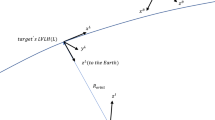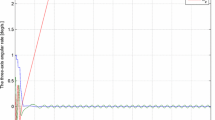Abstract
This research is on a realization of control approach in line with the trajectory optimization for the purpose of dealing with overactuated spacecraft in the process of the high-resolution manoeuvres. The idea behind the research is to realize closed control loops to cope with the rotational angles and the corresponding angular rates, synchronously, to handle the spacecraft manoeuvres. It is to be noted that the traditional techniques may not have sufficient merit to deal with such a complicated process, suitably. The proposed trajectory optimization is designed to provide the three-axis referenced commands, in finite burn, for transferring the aforementioned overactuated spacecraft from the initial orbit to its final outcomes in the orbital transfer process. The outcomes are realized through the variations of the orbital parameters, including the inclination, the eccentricity, the angular momentum, the semi-major axis and so on, in the high-resolution manoeuvres. It aims to get the system under control to guarantee the performance of the three-dimensional rotational angles tracking to be desirable, instantly. The contribution of the research is to make the high-thrust optimization trajectory, which is organized in association with the new configuration of the three-axis attitude control approach, to be applicable to manage the present overactuated spacecraft in the procedure of high-resolution orbital transfer process. The investigated outcomes of the research are efficient and competitive along with the potential materials through a series of experiments, as long as the desirable tracking performance in the three-dimensional space manoeuvres is apparently guaranteed.










Similar content being viewed by others
References
Olds A D, Kluever C A and Cupples M L 2007 Interplanetary mission design using differential evolution. J. Spacecr. Rockets 44(5): 1060–1070
Balkanyi L R and Spurlock O F 1993 DUKSUP—a high-thrust trajectory optimization code. NASA Lewis Research Center, Cleveland, OH
Yue X, Ma Y, Zhang X and Geng Z 2013 Trajectory optimization of continuous-thrust spacecraft round trip flights via pseudo spectral method. In: Proceedings of the 32nd Chinese control conference (CCC), 2240–2244
Yam C H, Di Lorenzo D and Izzo D 2010 Constrained global optimization of low-thrust interplanetary trajectories. In: Proceedings of the IEEE Congress on Evolutionary Computation (CEC), 1–7
Jiang X Y, Zhang H B and Tang G J 2013 A novel low-thrust trajectory optimization approach based on virtual gravitational body. In: Proceedings of the Chinese automation congress (CAC), 295–299
Jiang X Y, Lian Y J, Zhang H B and Tang G J 2013 A multi-impulse extended method for low-thrust trajectory optimization. In: Proceedings of the international conference on recent advances in space technologies (RAST), 36–368
Bando M and Yamakawa H 2010 Low-thrust trajectory optimization using second-order generating functions. In: Proceedings of the SICE annual conference, 804–810
Dai R, Maximoff J and Mesbahi M 2013 Optimal trajectory generation for establishing connectivity in proximity networks. IEEE Trans. Aerosp. Electron. Syst. 49(3): 1968–1981
Tian B, Fan W, Su R and Zong Q 2015 Real-time trajectory and attitude coordination control for reusable launch vehicle in reentry phase. IEEE Trans. Ind. Electron. 62(3): 1639–1650
Curtis H D 2010 Orbital mechanics for engineering students. Elsevier Aerospace Engineering Series, Butterworth-Heinemann, Burlington
Sidi M J 1997 Spacecraft dynamics and control: a practical engineering approach. Aircraft Industries Ltd. and Aviv University, Cambridge Aerospace Series 7. Cambridge University Press, Cambridge
He S, Wang W, Lin D and Lei H 2016 Robust output feedback control design for autonomous spacecraft rendezvous with actuator faults. Proc. Inst. Mech. Eng. I: J. Syst. Control Eng. 230(6): 578–587
Huang X, Yan Y, Zhou Y and Xu H 2015 Output feedback sliding mode control of Lorentz-augmented spacecraft hovering using neural networks. Proc. Inst. Mech. Eng. I: J. Syst. Control Eng. 229(10): 939–948
Song Z, Li H and Sun K 2014 Finite-time control for nonlinear spacecraft attitude based on terminal sliding mode technique. ISA Trans. 53(1): 117–124
Lu K and Xia Y 2013 Adaptive attitude tracking control for rigid spacecraft with finite-time convergence. Automatica 49(12): 3591–3599
Yang Y 2012 Spacecraft attitude determination and control: quaternion based PDLQR method. Annu. Rev. Control 36(2): 198–219
Mazinan A H, Pasand M and Soltani B 2015 Full quaternion based finite-time cascade attitude control approach via pulse modulation synthesis for a spacecraft. ISA Trans. 58: 567–585
Zou A M and Kumar K D 2011 Adaptive fuzzy fault-tolerant attitude control of spacecraft. Control Eng. Pract. 19(1): 10–21
Hu Q, Li B and Zhang Y 2013 Robust attitude control design for spacecraft under assigned velocity and control constraints. ISA Trans. 52(4): 480–493
Cai H and Huang J 2014 The leader-following attitude control of multiple rigid spacecraft systems. Automatica 50(4): 1109–1115
Kuo Y L and Wu T L 2012 Open-loop and closed-loop attitude dynamics and controls of miniature spacecraft using pseudo wheels. Comput. Math. Appl. 64(5): 1282–1290
Zhang X, Liu X and Zhu Q 2014 Attitude control of rigid spacecraft with disturbance generated by time varying exo-systems. Commun. Nonlinear Sci. Numer. Simul. 19(7): 2423–2434
Acknowledgements
The authors would like to express the best and the warmest regards to the respected editors of Sadhana and Springer Publisher as well as the respected anonymous reviewers, for suggesting their impressive, constructive, desirable and technical comments on the present investigation. Moreover, Dr. Mazinan sincerely appreciates the Islamic Azad University (IAU), South Tehran Branch, Tehran, Iran, which played a significant role in the process of paper investigation and organization. Maryam Aghaei Sarchali, Miss Mohadeseh Mazinan and also Mr. Mohammad Mazinan in the same area are greatly appreciated.
Author information
Authors and Affiliations
Corresponding author
Rights and permissions
About this article
Cite this article
Mazinan, A.H., Shahi, M. On high-resolution manoeuvres control via trajectory optimization. Sādhanā 42, 245–255 (2017). https://doi.org/10.1007/s12046-017-0599-7
Received:
Revised:
Accepted:
Published:
Issue Date:
DOI: https://doi.org/10.1007/s12046-017-0599-7




